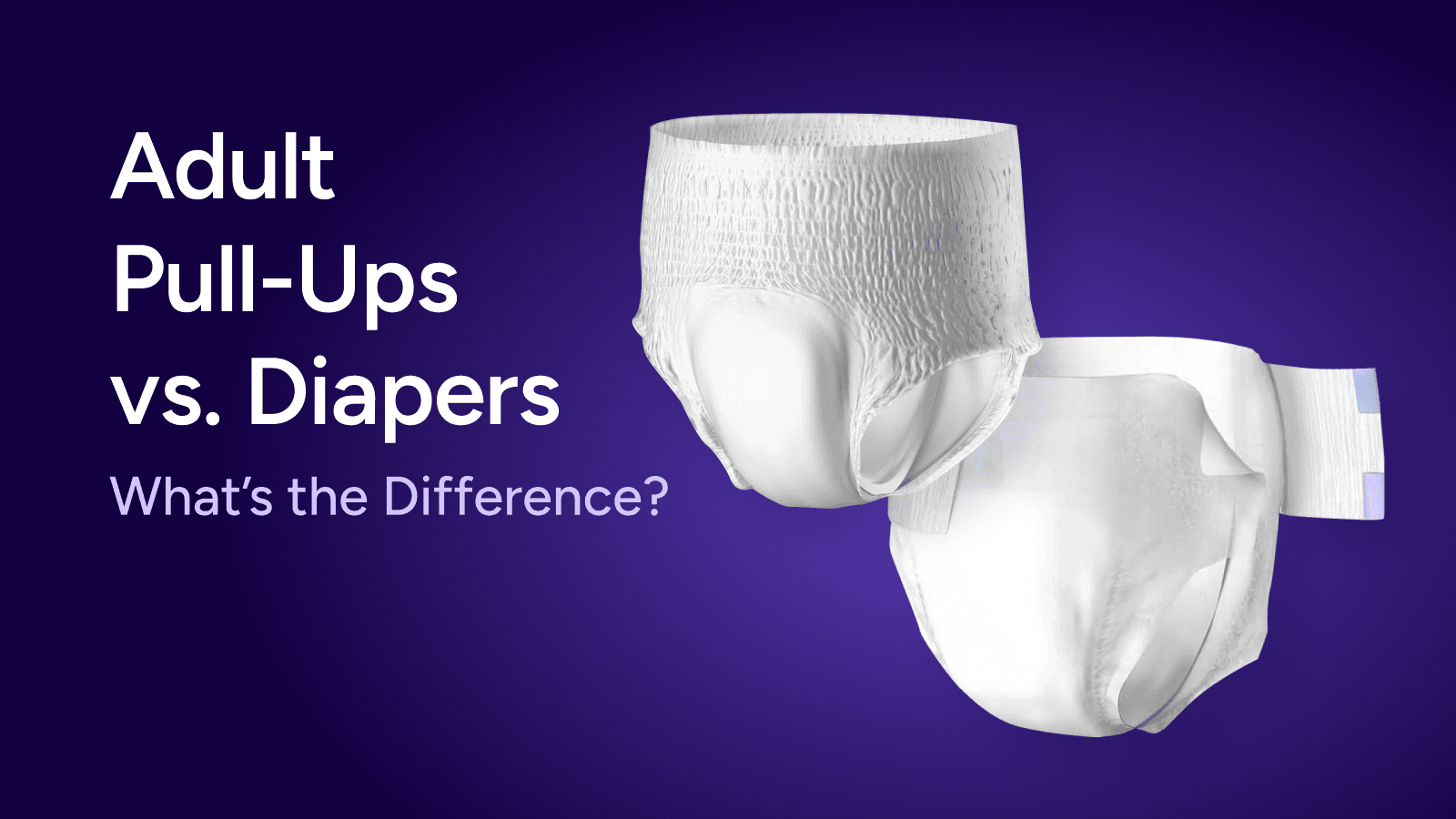Incontinence after a stroke affects between one-half and one-third of all stroke survivors.
Loss of bowel or bladder control can be worrisome and frustrating, but it isn’t necessarily permanent. Of the more than 795,000 Americans who suffer a stroke each year, only about 15% experience long-term issues.
Even so, incontinence presents unique challenges. It can affect your loved one’s self-esteem, and increase the risk of certain health problems, including diaper rash, urinary tract, and yeast infections.
Fortunately, stroke-related incontinence is relatively easy to manage and treat. A combination of healthy lifestyle changes, at-home exercises, medication, and regular doctor’s appointments can minimize accidents and improve your senior’s quality of life.
This article answers the following questions:
Why do strokes cause incontinence?
A stroke occurs for one of two primary reasons –– a blocked artery (ischemic stroke) or a burst or leaking blood vessel (hemorrhagic stroke).
These factors significantly reduce blood flow to the brain, cutting off oxygen and nutrients. Within minutes, the lack of circulation results in tissue death, which can affect neurological function.
There are several factors that increase the risk of urinary and bowel incontinence after a stroke, including:
Brain damage. In some cases, a stroke damages the part of the brain responsible for bladder and bowel control. When this occurs, you might not experience an urge to use the bathroom, even if you have to go.
Weakened muscles. Often, strokes affect the muscles responsible for bladder and bowel control. The weaker these muscles become, the more difficult it is to hold in urine or a bowel movement.
Mobility issues. Following a stroke, many people experience problems with coordination and balance. That can make it difficult to get to the bathroom on time, even if you have the urge to go. In addition, being wheelchair-bound or bedridden encourages constipation, increasing the risk of fecal incontinence.
Difficulty communicating. A stroke may affect an individual’s ability to form words and sentences. This can prevent stroke victims from alerting caregivers of an impending void.
Medication. Certain drugs affect bowel and bladder control. For example, diuretics, a type of medication that lowers blood pressure, help the kidneys process excess fluid. One of the most common side effects is the need to urinate more frequently.
What are the types of stroke-related incontinence?
There are several types of stroke-related incontinence, including:
Urinary incontinence
Urinary incontinence refers to the involuntary leakage of urine and affects everyone differently. For some, it causes minor involuntary leakage; for others, it causes a complete inability to control urination.
Urinary incontinence falls into several subcategories, including:
Frequency incontinence: The need to use the bathroom repeatedly.
Stress incontinence: Urinary leakage that occurs when coughing, laughing, or sneezing, due to weak pelvic floor muscles.
Urge incontinence: A sudden urge to urinate, triggered by involuntary muscle spasms.
Reflex incontinence: Leakage that occurs involuntarily, due to stroke-related brain damage.
Nocturnal incontinence: Urinary voids that occur during sleep.
Overflow incontinence: Urinary incontinence that occurs due to nerve damage or a loss of feeling in the bladder.
Functional incontinence: A stroke can affect muscle control and coordination, making it difficult to undo a belt or zipper, which may increase the risk of an accident.
Fecal incontinence
Fecal incontinence refers to involuntary bowel voids and falls into several sub-categories, including:
Constipation with overflow: Lack of movement during stroke recovery often causes stools to harden and block the colon. Liquid stool from the upper digestive tract can flow past these blockages, resulting in watery voids.
Reflex incontinence: This type of fecal incontinence occurs involuntarily, due to stroke-related brain damage.
Fecal impaction: This refers to a dry, hardened lump of stool that becomes trapped in the lower colon or rectum. As the mass grows larger, it can press on the bladder, causing double incontinence, or a void of both urine and fecal matter.
How can I manage stroke-related incontinence?
There are a variety of ways to manage stroke-related incontinence. The method that will most benefit your senior depends on several factors, including their medical history, the underlying cause (ie: brain damage, muscle spasms, etc.), and the type of incontinence experienced.
Tips for managing urinary incontinence after a stroke
Some of the most common strategies used to manage urinary incontinence include:
Pelvic floor exercises: The pelvic floor is a hammock-shaped group of muscles that support the bladder and bowels. When they’re weak, it’s common to experience involuntary leaks. Pelvic floor exercises like Kegels can strengthen these muscles, lowering the risk of accidents. Read more: Combating Incontinence with Kegels
Prescription medication: Some types of stroke-related urinary incontinence benefit from medication. There are various drugs available that can limit feelings of urgency or reduce the production of urine altogether.
Bladder training: Bladder training teaches the bladder to hold more urine. It encourages you to use the bathroom frequently, slowly lengthening the time between each visit.
Losing weight: Being overweight can exacerbate urinary incontinence. Losing just 5-10 pounds reduces pressure on the bladder and pelvic floor.
Monitoring fluid intake: The more your loved one drinks, the more they’ll need to urinate. Controlling the number of fluids they consume can make it easier to predict the next time they’ll need to go.
Tips for managing fecal incontinence
Some of the most common strategies used to manage fecal incontinence include:
Bowel training: Similar to bladder training, bowel training encourages frequent visits to the bathroom, usually after meals. By having a bowel movement at the same time each day, it’s possible to prevent involuntary voids.
Medication: There are a number of drugs used to treat fecal incontinence. Some tighten the anal sphincter to prevent unwanted leakage, while others help loosen the stool, making it easier to pass.
Dietary changes. The foods a person consumes directly affect their bowel habits. Fruits and vegetables that are high in fiber minimize constipation by softening the stool. Fiber can also prevent diarrhea by absorbing water, making the stool bulkier.
How does stroke-related incontinence affect mental health?
Incontinence after a stroke isn’t just a physical problem — it presents psychological challenges as well. Even though the condition is common, many individuals experience feelings of embarrassment, shame, and depression. When left unaddressed, these emotions can fester, resulting in social isolation and poor quality of life.
You might not be able to speed up your loved one’s recovery process, but you can support them during this difficult time. If you suspect incontinence is affecting your senior’s mental health, let them know you’re there to offer support. You can also request an appointment with their primary care physician to discuss treatment options like talk therapy or an incontinence support group.
What incontinence items should I include in a stroke recovery kit?
At Carewell, we carry many products that can assist with incontinence after a stroke. Here’s a closer look at three of our most popular offerings:
Prevail Total Care Underpads, Super
Many stroke survivors wear adult diapers or pull-ups in the initial stages of recovery. Prevail Total Care Underpads provide an additional layer of protection, preventing overflow leaks from soiling clothing, bedding, or furniture.
Key Benefits & Features:
Plastic backing to prevent leaks from soaking through
No clean-up required; simply toss it in the trash can
Each underpad has an absorbent core that locks moisture in
McKesson Male Urinal
This plastic urinal from McKesson is ideal for men experiencing urinary incontinence. The contoured handle conveniently attaches to most bed rails and holds up to 32 oz. of urine.
Key Benefits & Features:
Includes a lid to prevent spills and odors
Free of allergens, including rubber and latex
Easy to clean and sterilize
McKesson Commode Chair with Fixed Arm
A bathroom environment presents unique challenges to stroke victims. The small space and slippery surfaces may increase the risk of an accident like a slip-and-fall. McKesson’s commode chair with fixed arm can provide peace of mind. It has a folding-steel frame that allows for easy transport as well as plastic armrests that provide comfort and support.
Key Benefits & Features:
Supports up to 350 pounds of weight
Includes a 7.5-quart commode bucket with handle for easy disposal
Non-skid tips for improved safety
Hassle-free assembly (no tools required)
What if I have questions regarding incontinence products?
Caring for a stroke survivor with urinary or bowel dysfunction presents unique challenges. Our friendly and compassionate Care Team will be happy to assist you in finding the products that best align with your needs. To get in touch, call (800) 696-CARE or email support@carewell.com.



